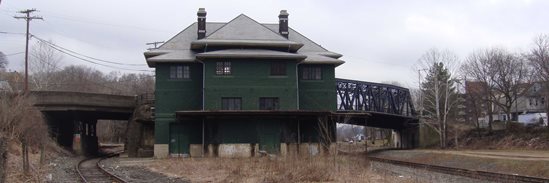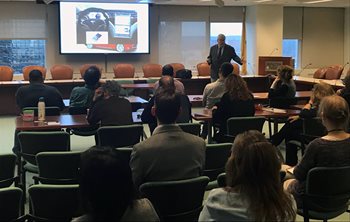April 2019
Posted: 4/22/2019 1:15:41 PM

A strong growth in demand for freight rail services in northern New Jersey is prompting major rail investments, boosting the prospects for attracting new companies and jobs to the region. That was a key insight delivered by three industry officials at the April 15 NJTPA Freight Initiatives Committee meeting.
Freight Initiatives Committee Chair Charles Kenny, a Middlesex County Freeholder, welcomed the speakers, noting that the briefing was an annual event to provide the committee an update on the status of freight rail in the region.
The first speaker was Timothy Tierney, President & Chief Operating Officer, Conrail Shared Assets. He said that Conrail is jointly owned by Norfolk Southern and CSX, handling traffic to and from the port and the region for over 200 customers. It interfaces with 11 of the 15 smaller shortline railroads in the region. He said port and intermodal traffic has grown 16 percent from 2017 to 2018.
As a result, Conrail is investing $21 million in upgrading rail infrastructure. This includes the Waverly Loop project, which is set to go to construction next year. It will add another route for rail freight in and out of the port. Another major project is reconstruction of the Point No Point bridge over the Passaic River which is planned for construction in 2021.
The next presenter was Kean Burenga, President and Managing Partner, Chesapeake & Delaware, which operates four shortline rail services in the NJTPA region. It recently started operations of a new shortline, the Dover and Delaware River Railroad, over 109 route miles that include the lease of the Washington Secondary line from Norfolk Southern and trackage rights over several NJ TRANSIT lines. This railroad currently serves 14 customers.
The company is undertaking projects to improve the line to better serve existing customers and attract new ones. Of particular importance are upgrades needed to accommodate the national standard taller and heavier rail cars.
He noted that one “hugely important project” is addressing the vertical clearance restriction under the South Main Street Bridge over the Washington Secondary line in Phillipsburg (pictured above) by replacing wooden ties with low profile steel ties. Other projects in the pipeline include upgrading interchanges and grade crossings.
The third presenter was Dan Mulligan, Director of Sales and Marketing, Global Container Terminals. The Global Terminal in Bayonne, he said, is a 170-acre facility with eight cranes for moving containers to and from vessels. It operates with an innovative appointment system for truckers which reduces delays and improves efficiency.
The ExpressRail Port Jersey on-dock rail facility became operational at half capacity in January and will be operating at full capacity with a total of 9,600 feet of track later this year. The new facility provides the terminal with significant cost and time savings for service to the Midwest over its competitors and reduces the amount of terminal related truck traffic. In addition to the new on-dock rail facility the terminal continues to make capital investments and operational improvements to accommodate the growing trade.
The committee meeting also included a presentation by Richard Semenick, Associate Vice President, HDR on the NJTPA’s Freight Rail Industrial Opportunity (FRIO) Corridors Program which is being finalized. HDR is NJTPA’s consultant on the project.
[April 22, 2019]
Posted: 4/4/2019 12:00:00 AM
 Automated vehicles will prompt a “seismic shift” in American society comparable to what occurred with the advent of the smart phone, says Mitchell Erickson, consultant and retired science advisor, U.S. Dept. of Homeland Security. Once in common use, they will forever alter our lifestyles and the physical layout of our communities, he predicts.
Automated vehicles will prompt a “seismic shift” in American society comparable to what occurred with the advent of the smart phone, says Mitchell Erickson, consultant and retired science advisor, U.S. Dept. of Homeland Security. Once in common use, they will forever alter our lifestyles and the physical layout of our communities, he predicts.
Erickson offered his insights in a briefing to NJTPA staff titled “Mobility in 2050: Who Knows? How to Prepare for the Unknown” on March 30. He said there will be winners and losers in the transition to automated vehicles. Travelers will benefit from increased mobility options and dramatic increases in safety -- with traffic deaths reduced by as much as 90 percent. But many of those involved in our current car culture, including Uber and Lyft drivers, could lose their jobs.
The pace of the deployment of automated vehicles will depend on companies’ ability to make them efficient, trusted, hackproof and accepted by consumers, he said. “There are huge uncertainties in our future.” he said. Transportation agencies such as the NJTPA must be “willing to plan for contingencies,” he advised.
Declining demand for private automobiles, he predicted, could one day dramatically alter housing arrangements and land use, including eliminating the need for garages, roadside gas stations and much parking. In suburban areas, he said, as much of 20 percent of land area is used for parking. “What do we use all that space for?” he asked.
Instead of offering free parking or coupons to draw customers, he envisioned, retail outlets, could offer automated vehicle trips to and from people’s homes. If deployed efficiently, the vehicles could help reduce greenhouse gas emissions, 26 percent of which currently come from the transportation sector.
At the same time, he said, his background in Homeland Security made him aware of potential threats such as use of automated vehicles, drones and other systems for terrorist or criminal activities.
He said while change is coming to the transportation sector “big time,” transportation agencies like the NJTPA have a “chance to shape that future” through current plans and programs.